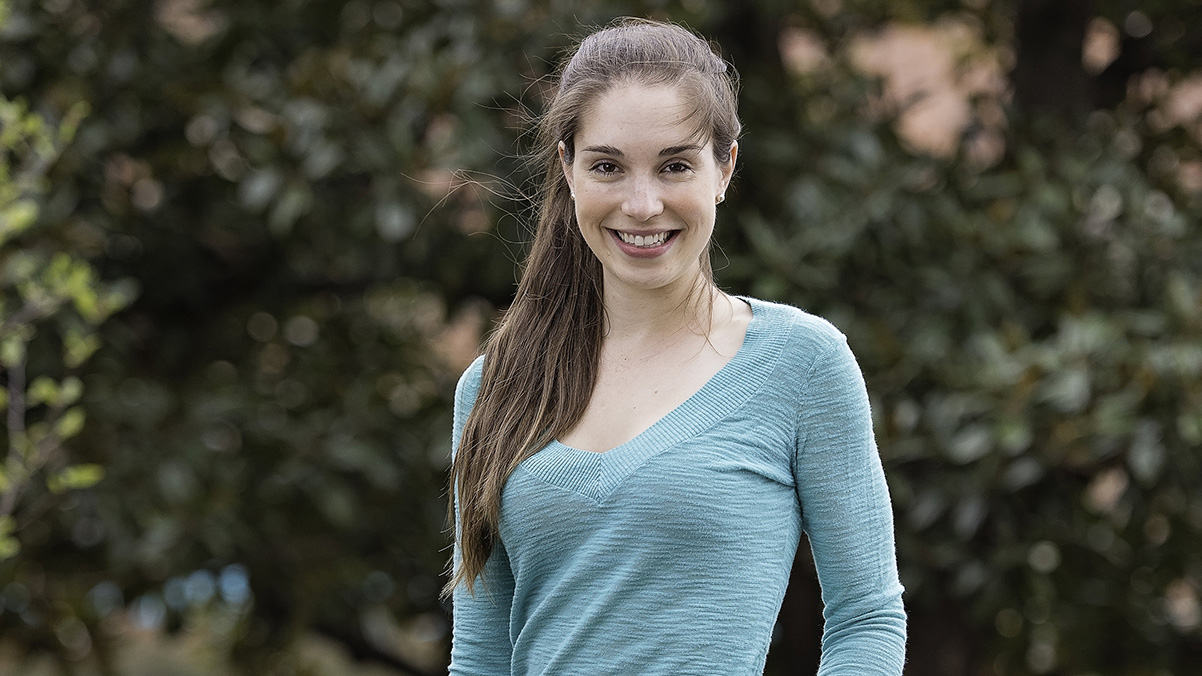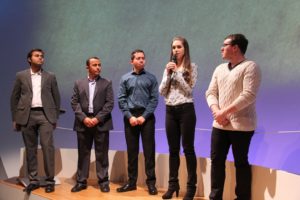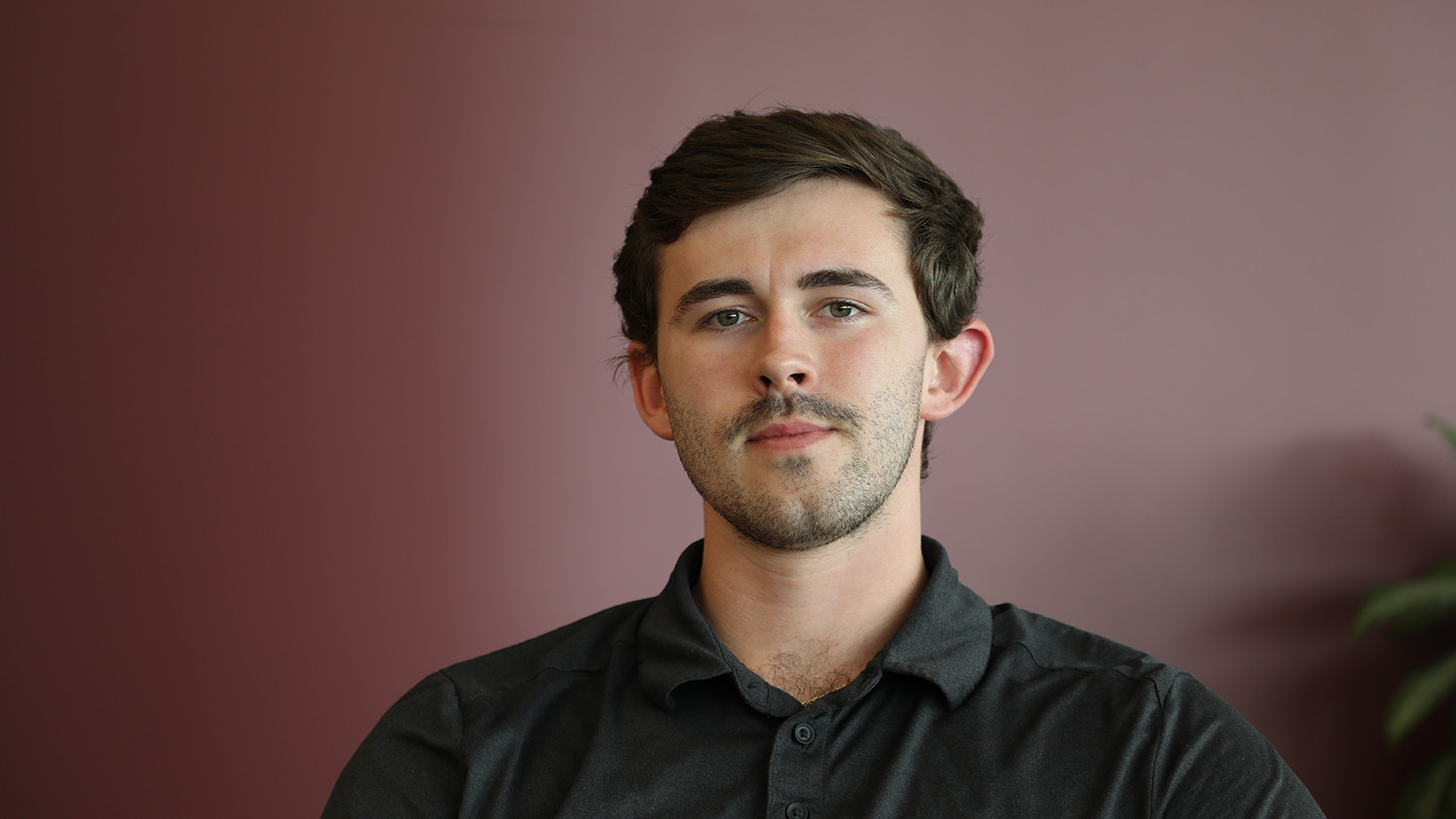Sophia Webster

NC State’s Department of Entomology and Plant Pathology is working to prevent disease transmission. Sophia Webster is on the front lines.
Inside the Duke Energy Hall at the James B. Hunt Library last October, Sophia Webster took to the stage as the fourth contestant in the Three Minute Thesis competition. The competition was hotly contested. All were PhD candidates selected during preliminary rounds. Only ten finalists remained.
Webster paused and squared her shoulders before beginning her carefully timed, three-minute speech. Looking much taller than her 5’7”, she explained her doctoral work. The title alone was a mouthful.
“Genetically Engineering a Killer-Rescue Gene Drive in Aedes aegypti” was the minutes-long topic of Webster’s doctoral thesis. (Much-distilled, too, as a thesis can often run to as many as 80,000 words or more.)
The research, which concerns modifying the mosquito that carries Zika to render the population unable to transmit disease, found an attentive audience. In minutes, Webster shared how researchers might intervene to replace the mosquito population with one that can no longer transmit disease.
Unchecked, the common pest can carry uncommonly dangerous viruses, such as dengue fever, yellow fever, Zika, and malaria. “Aedes albopictus is one of the dominant mosquitoes in North Carolina,” Webster explains. It is capable of transmitting Zika, but it is not an important vector for Zika that we know of.”
Webster’s subject matter had captivated the 3MT audience. It was early fall, but the problem of Zika transmission remained a dominant news theme. The disease had become a media topic of ever-greater frequency, with devastating consequence for pregnant women and children, and also affecting otherwise healthy adults. Although the Zika virus has been identified for over 70 years, it had slowly advanced into the public arena as a dominant public health worry. Zika was spreading within the United States.
When the competition ended, Webster won the People’s Choice Award and a hefty cash prize. Beside me, a cheering student nodded and murmured, “Good for her! She deserves it!”
Another thing that Webster had successfully communicated was this: The tedious and long work of genetically modifying mosquitoes required patience. “And even more than patience… it feels like a lot of luck. Sometimes the genes go into the organism and stick, and sometimes they don’t.”
A month later, she detailed the challenges of the work. “I’m not trying to kill mosquitoes,” she explained while working at NC State’s Thomas Laboratory. “After all, there are over 4,000 species of mosquitoes,” she pointed out. To eradicate their populations would be nearly impossible, and eradication efforts have been met with little success. Genetically modifying disease-transmitting pests, however, was another matter.
Meanwhile, NC State researchers had not been idle. As Webster had explained last fall, she and fellow scientists had been exploring new options. They chose a different tactic than British biotech researchers, who released sterile mosquitoes into the wild.
“My research is not using sterile mosquitoes; instead, it is a gene drive system that will use releases of genetically engineered mosquitoes to push an anti-pathogen gene through the wild population. The only way for this anti-pathogen to spread at a biologically relevant timescale is for mosquitoes that do not inherit the anti-pathogen to die. (This is part of the system I am
building.) This ensures that only mosquitoes that inherit the antipathogen survive, and those that do not inherit it die.”
Inside NC State’s Insect Transgenesis Facility, Webster used a micro-injector and a screening scope after first completing molecular and cloning work in attempts to ultimately alter the genome of Aedes aegypti.
The preparation and hatching of eggs is the first of many intricate procedures she must undertake.
Days yield to months as Webster works through the steps. A female mosquito first requires a blood meal in order to produce eggs, which must then be harvested and injected with genetic material before incubation.
“I’m creating genetically engineered mosquitoes with a system that will drive an anti-pathogen through a wild population. You have to manipulate things for a mosquito to inherit this,” Webster explains. “This way, the system will force the population to inherit this anti-pathogen. By releasing this genetically engineered mosquito, when they mate with the wild population, only the mosquitoes who inherit the anti-pathogen will survive. Those mosquitoes who do not inherit the anti-pathogen, thus those that are still able to transmit disease, will not survive.”
The modeling for a Killer-Rescue, or K-R, gene drive system was the brain child of two NC State professors, Fred Gould and Alun Lloyd. They published the modeling paper for the K-R system in 2008. “They came up with the idea, initially called ‘Killer-Rescue.’ They modeled the idea of suppressing the population and replacing it with this anti-pathogen,” she says.
Max Scott, Webster’s advisor, has guided her portion of the K-R effort, which involves isolating different genes from the mosquito in order to help create their system. “The portion I am working on is the killer and rescue component, but not the antipathogen–other researchers are focused on this effort.”
[marketing-quote color=’blue’ align=’center’]With over 4,000 species of mosquitoes, new technology is not to kill them, but change the population.[/marketing-quote]
She explains: “I’m building the car (gene drive system), and other researchers are working on putting the passenger (antipathogen) in it. The technology I’m working on doesn’t spread as quickly as other gene drive systems; it only spreads by the mosquitoes that don’t inherit the antipathogen dying, and the ones that do inherit survive to pass on the inability to transmit disease to the next generation of mosquitoes.”
Webster discusses how other researchers do similar work, employing different tools. “Others work with the anti-pathogen component, but I work with the vehicle that will push the antipathogen
through the population. Theoretically, with the system I’m building, any anti-pathogen could be linked up to the system and pushed through using the Killer-Rescue gene drive.”
Ultimately, she will do small cage experiments with her line, but which won’t entail releases into the wild. That, she hopes, will come in time.
The NC State research is attractive on many fronts. Outright eradication is simply not feasible—the sheer variety of mosquitoes is too staggering and widespread spraying is frowned upon in many regions of the United States for environmental reasons.
The rollout is months long in the orchestrating. The work of genetically modifying/engineering mosquito embryos is not fast nor can it be. Over the next four to six weeks, Webster screens 20,000 mosquito larvae underneath the screening microscope. The minute larvae must be kept on a wet sponge.
“We screen the larvae because adults can fly,” she says. “The larvae are so fragile and must be kept moist at all times since they are aquatic. I take a tiny paintbrush and try to move them without squishing them or letting them dry out. When I first found one, identified by fluorescent glowing red eyes, I ran into my PI’s office! It was so exciting, having a line of genetically engineered mosquitoes finally going.”
Webster must even make the needles used for the injection of the genetic material into the eggs, material “which will alter the mosquito’s genome if successfully assimilated.” The prepared genes are called a construct.
Each step is undertaken under strict controls and setbacks are commonplace.
“It can take months to build a construct. I’ve made 12 different ones.” Then Webster must line up the eggs and inject them. “I had an entomology background, but not one in genetics, so it was a learning curve,” she adds.
When Webster injects the mosquito eggs with genetic material, she deals with thousands at a time—yet another tedious process. “It can take up to 10 days of injections, injecting 200-600 a day. Afterwards, you keep them in a moist warm place and hatch them.” The larvae are always hatched in distilled water. On one occasion, Webster discovered something amiss with the lab’s distilled water tank.
“I had a good hatch rate after spending numerous long days injecting—a bunch swimming around. The next day they were dead.” She guesses the chlorine in the water killed them, and shrugs.
Soon after hatching the eggs, Webster looks for tell-tale green, or red, fluorescence in the larvae which alerts her if the genes are successfully integrated into the mosquito—the genes that will render it genetically modified.
“The transformation efficiency is only 1-5 percent,” Webster explains. “It is not without its many difficulties, but I have no doubt this will be done in the future,” she says confidently. Actually, she already knows her research is working.
Four to six weeks afterward, she screens to determine if the mosquitoes have developed the tell-tale killer or rescue traits by the mosquito’s eye color. “The eye marker is a fluorescent protein isolated from jellyfish; it fluoresces their optic nerves. The rescue has red, but the killer has green eyes.”
After many hundreds of efforts, Webster says “I often see the mosquito larvae when I close my eyes,” and smiles.
She has the resilience and patience of a marathoner, which is her release. At least running allows Webster to control the pace—something that is nearly impossible to do inside a lab.
Webster, fit and intense, is an avid runner. She was part of a 200-mile coastal relay race only two weeks earlier. “I ran about 36 miles of the relay,” she says, downplaying the achievement.
As she discusses her early love of science, Webster throws up her hands. There are no scientists in her immediate family. Her father works in international development and her mother is an English teacher. Yet there was a definite focus upon exploration and knowledge, she explains. Curiosity was something that was nurtured—especially by time spent in the outdoors away from TV screens.
“When I was a little kid, we didn’t have cable or video games,” Webster explains. “So, my Mom would shoo us out the door and say, ’Go play outside!‘ I loved playing in the dirt. I remember playing outside into the evenings, staying outside with my sister.” Webster was so at home in the natural world that this no doubt jump-started her growing love of science.
As a teenager, Webster decided to become a medical doctor or a physicist. She attended Virginia Tech, studying biology as a foundation for medical studies. In her junior year, she accepted an internship at INOVA hospital in Fairfax, Va., working with a cardiac surgeon to preview what she believed would be her future occupation.
“I observed a few different surgeries. By the end of the summer, I realized it wasn’t what I wanted to do. I didn’t want to be in a hospital all day.”
So Webster abandoned the idea of medical school and explored other options in STEM fields. She became a teaching assistant to an entomology professor. Although entomology satisfied her curiosity about the natural world, she found it wasn’t her true niche. “I collected insects, and I was really into bees; but, I still wanted to tie something back to human health.”
In her last year at Virginia Tech, Webster applied to NC State, noticing a National Science Foundation IGERT fellowship (for integrated graduate education research training). The IGERT program, by definition, means to catalyze a cultural change in graduate education, for students, faculty and institutions and focuses upon collaborative research outside the usual boundaries.
The fellowship also offered a generous stipend and tuition waiver.
The fellowship was unlike anything Webster had done. “We had students in communications, biomathematics, economics and biology.” Webster, of course, was the biology student.
Webster clicked with the IGERT agenda, which prepares scientists to be expert communicators. They learn to “talk about the controversy that genetic engineering raises in economic,
cultural, social and technological settings. The IGERT has played a huge role in my development as a graduate student.”
The fellows’ very first course was a month-long course which took place in Lima and Iquitos, Peru. In order to speak a common language, the fellows had to learn how to communicate across disciplines. The group of six was required to begin working towards publishing on an assigned topic by the beginning of 2016.
The students’ work was ultimately published in Genetic Control of Malaria and Dengue. Since then, The Genetic Engineering and Society program has been developed in the Hunt Library.
The group project also became a useful bridge to Webster’s present doctoral research. Webster began working within the area of genetic engineering and its role in society. “My research didn’t change, because I’m not working with the virus whatsoever. I’m tackling the vector (mosquito) and not the virus. Any mosquito virus could theoretically be tackled by the system I’m trying to build.”
Webster’s experiences as an IGERT fellow had also enabled her to better communicate her science—something that no doubt helped her to compete successfully in the 3MT competition last fall. This, she says, is immensely important. The public must understand scientists’ work if they are to value it, especially the highly controversial topic of genetic engineering.
Four years into her doctoral work, Webster will graduate in December 2017. With some luck, her next stop will be the Centers for Disease Control in Atlanta. Webster already plots her course, methodically and patiently; knowing well that life for a researcher is not a sprint, but a marathon.
3MT FINALISTS SHARE RESEARCH AT SCIENCE MUSEUM

It is a Saturday afternoon in downtown Raleigh, and there is a crowd at the Museum of Natural Sciences’ Daily Planet Theater. Visitors have taken a break from their museum tour to listen to five NC State graduate students share
their research presentation from the Three Minute Thesis.
Three Minute Thesis is an international competition where PhD students share their dissertation research in just three minutes. NC State has hosted its own competition since 2015, and the 2016 competition was held in October. Ten finalists competed, and Sophia Webster was chosen the “People’s Choice” winner by the audience.
The five NC State 3MT finalists came to the museum in December to share their research with the public and show off the high quality of research conducted by graduate students at NC State. The finalists gave their 3MT presentations, with the single slide they prepared for the competition. Afterward, the five students took audience questions about their research, pleased with the opportunity to engage the public in conversations about science.
—Natalie Hampton
Read more from the Graduate School’s Think Magazine.
Learn about graduate programs in entomology.
Download this article as a PDF.
Watch Webster’s Three Minute Thesis presentation.
- Categories:


